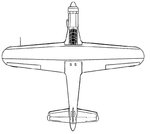Can I offer you one... the French decide to do a post war development on the Ta152c.... reengineer with Bristol Centaurs power egg from the Sea Fury ...
Remove the extension plug at the tail added with the Fw190D to balance out the long nose of the inline.... and a Bristol Centaurs Ta152c looks like a super Fw190A... the fuselage and wing root guns must go so those bays get extra fuel tanks ..... and the out board mg151 gun bay get double up to 2 guns so you back to 4 20mm total
And now for something completely different a He162 seaplane
Because of the high mount engine the He162 is a natural to get made in to a seaplane ...a fighter that can operate off lakes ...and a lake is a runway that can never be bombed out of operation ...
Remove the landing gear and scab on a seaplane hull on the lower fuselage.... think P6M Seamaster like hull .... the guns go up to the wing roots
Remove the extension plug at the tail added with the Fw190D to balance out the long nose of the inline.... and a Bristol Centaurs Ta152c looks like a super Fw190A... the fuselage and wing root guns must go so those bays get extra fuel tanks ..... and the out board mg151 gun bay get double up to 2 guns so you back to 4 20mm total
And now for something completely different a He162 seaplane
Because of the high mount engine the He162 is a natural to get made in to a seaplane ...a fighter that can operate off lakes ...and a lake is a runway that can never be bombed out of operation ...
Remove the landing gear and scab on a seaplane hull on the lower fuselage.... think P6M Seamaster like hull .... the guns go up to the wing roots
Last edited:



